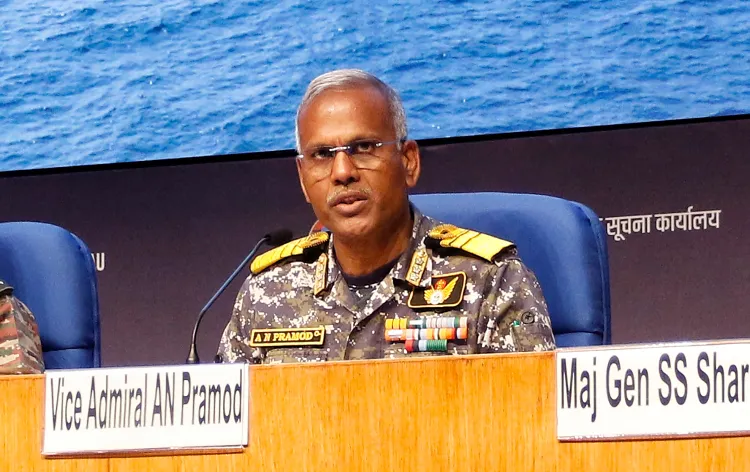How Did Karachi Become a Target During Operation Sindoor?

Synopsis
Key Takeaways
- Indian Navy played a crucial role in Operation Sindoor.
- Response was in light of the Pahalgam terror attack.
- Naval forces effectively restricted Pakistan Navy's movement.
- All branches of the military coordinated for a swift response.
- India emphasized precision to avoid civilian casualties.
New Delhi, May 12 (NationPress) - For the first time, the Indian Navy disclosed the significant involvement of naval forces during Operation Sindoor, launched in the aftermath of the Pahalgam terror attack that tragically claimed the lives of 26 civilians, the majority of whom were tourists.
The Navy stated that its strategic deployment in the Arabian Sea during Operation Sindoor effectively compelled the Pakistan Navy to remain confined to its harbors or close to the coast.
Vice Admiral A.N. Pramod, Director General of Naval Operations, indicated that the Indian Navy was fully prepared within 96 hours post-attack to carry out strikes targeting Pakistan’s military installations during Operation Sindoor.
He confirmed forces were “ready to strike at sea and on land, including Karachi Port,” but awaited directives from the government.
In a joint briefing with commanders from all three armed forces, he highlighted the Navy's swift mobilization of warships, submarines, and aircraft in full combat readiness following the brutal attack on April 22.
This deployment demonstrated India’s unwavering commitment to national security and its capability to respond effectively to emerging threats. Numerous weapon drills were conducted in the Arabian Sea to validate operational effectiveness and enhance strike precision. According to the senior navy officer, Pakistan’s naval forces were confined to defensive positions along the coastline and were under close surveillance.
“The Indian response during the operation was measured and coordinated, with all military branches working in unison to ensure an effective counter-strike,” he added.
Vice Admiral Pramod stressed that, alongside the Army and Air Force, the Navy’s overwhelming superiority at sea prompted Pakistan’s urgent request for negotiations. Despite the halt in hostilities, the Navy remained vigilant and prepared to respond decisively to any future threats from Pakistan or its proxies.
Lieutenant General Rajiv Ghai, India’s Director General of Military Operations, confirmed that Pakistan had been cautioned against any further violations, which would face severe retaliation.
Air Marshal A.K. Bharti provided insights into the precision airstrikes that targeted Pakistani military installations, reaffirming India’s dedication to avoiding civilian casualties while executing a calculated response.
Bharti stated that India’s conflict was not with the Pakistani military, but with terrorist elements operating across the border. However, ongoing UAV and drone incursions necessitated a retaliatory response while maintaining proportionality. Despite relentless attacks, India’s air defense systems effectively neutralized incoming threats, he noted.
In summary, Operation Sindoor highlighted India’s strategic capability to deter hostile actions while bolstering national security. The military’s coordinated approach ensured a swift and effective response, delivering a clear message that any further aggression would be met with overwhelming force. The Indian armed forces remain on high alert, prepared to counter any future threats while maintaining stability in the region.










